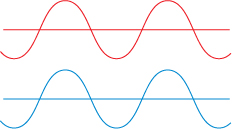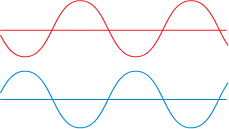Module 8—Mechanical Waves
Constructive and Destructive Wave Interference
 Read
Read
What is constructive interference or destructive interference of waves? Read “Superposition of Pulses and Interference” on pages 411 to 413 of your textbook to help understand what the following assignment questions are about.
Consider what happens when two waves of identical wavelength combine. There are three possible cases:
- in phase (crest meets crest)
- out of phase (crest meets trough)
- intermediate phase (crest meets neither crest nor trough)
Case 1: In Phase

In this case, the crests (and troughs) line up, as illustrated. The waves will combine constructively and produce the largest possible combined amplitude.
Use the Wave Phase and Interference simulation to explore this. Choose 100 m as the wavelength, and make sure that the amplitudes for both waves are the same. Use the “down” arrow to move the waves closer to each other. Slide the phase scrollbar back and forth, and note when the waves match up crest to crest or trough for trough. These are the conditions for constructive wave interference. Such waves are said to be in phase.
 Module 8: Lesson 3 Assignment
Module 8: Lesson 3 Assignment
Remember to submit the answer to TR 3 to your teacher as part of your Module 8: Lesson 3 Assignment.
 Try This
Try This
TR 3. The green waveform at the bottom of the simulation shows the combined waveform. Sketch the waveform when the two waves are in phase or complete constructive interference. Compare the amplitude of the combined waveform with the amplitude of the individual waveforms. Which wave has the larger amplitude?
Case 2: Out of Phase
destructive wave interference: overlapping of waves so crests match with troughs

In this case, the crest of one wave lines up with the trough of another, as illustrated.

The waves will undergo complete destructive wave interference.
Use the Wave Phase and Interference simulation to explore this. Again, adjust the phase by moving the phase scrollbar, and observe when complete destructive interference occurs. When this occurs, the waves are said to be "completely out of phase."
 Module 8: Lesson 3 Assignment
Module 8: Lesson 3 Assignment
Remember to submit the answer to TR 4 to your teacher as part of your Module 8: Lesson 3 Assignment.
 Try This
Try This
TR 4. The green waveform at the bottom of the simulation shows the combined waveform. Sketch the waveform when the two waves are completely out of phase or complete destructive interference. Compare the amplitude of the combined waveform with the amplitude of the individual waveforms. Which wave has the smaller amplitude?
Case 3: Intermediate Phase

In this case, neither crests nor troughs line up, as illustrated.
The waves still add, but they no longer cancel completely or add up to the maximum possible amplitude.
Use the Wave Phase and Interference simulation to explore this. Again, adjust the phase by moving the phase scrollbar, and observe when this occurs.
 Module 8: Lesson 3 Assignment
Module 8: Lesson 3 Assignment
Remember to submit the answer to TR 5 to your teacher as part of your Module 8: Lesson 3 Assignment.
 Try This
Try This
TR 5. The green waveform at the bottom of the simulation shows the combined waveform. Sketch an example of the combined waveform when the two waves undergo intermediate interference, and compare the amplitude of the combined waveform with the amplitude of the individual waveforms.
 Self-Check
Self-Check
SC 2. In the simulation, use the phase scrollbar to determine how big a phase shift (in radians) must be introduced between waves so that complete destructive interference occurs. What two other conditions must also be met in achieving complete destructive interference?
SC 3. Adjust the amplitude of wave 1 to be 10 units and wave 2 to be 20 units. Choose a wavelength of 100 m. (This makes the waves large enough to be easily seen.)
- What is the maximum possible amplitude of the combined wave when
wave 1 and wave 2 constructively interfere?
- What is the minimum possible amplitude of the combined wave when wave 1 and wave 2 destructively interfere?
 Self-Check Answers
Self-Check Answers
SC 2. Any odd multiple of π (3.14) radians causes complete destructive interference (e.g., 1π, 3π, −3π, 5π, −5π). The two conditions that must be met are
- the two waveforms have equal amplitude
- the two waveforms have equal wavelength
SC 3.
- Maximum possible amplitude of the combined waves when they constructively interfere is 10 units + 20 units = 30 units.
- Minimum amplitude of the combined waves when they destructively interfere is 20 units − 10 units = 10 units.
 Module 8: Lesson 3 Assignment
Module 8: Lesson 3 Assignment
Remember to submit the answers to TR 6 and TR 7 to your teacher as part of your Module 8: Lesson 3 Assignment.
TR 6. Adjust the amplitude of wave 1 to be 5 units and wave 2 to be 12 units. Choose a wavelength of 100 m. (This makes the waves large enough to be easily seen.)
- What is the maximum possible amplitude of the combined wave when
wave 1 and wave 2 constructively interfere?
- What is the minimum possible amplitude of the combined wave when wave 1 and wave 2 destructively interfere?
TR 7. Two waves are originally in phase. If one of the waves is shifted by 4π radians, the waves will now be completely out of phase. Is this statement true or false? Explain your answer.
 Watch and Listen
Watch and Listen
Use this Superposition Principle of Wave simulation to visualize the principle of superposition when two identical waves meet. Stop the action by right-clicking (press the button on the right side of your mouse), and change the frequency to 4.0 Hz for both waves. Press “Enter” and right-click again to start the action. You can stop or start it at any time by right-clicking.